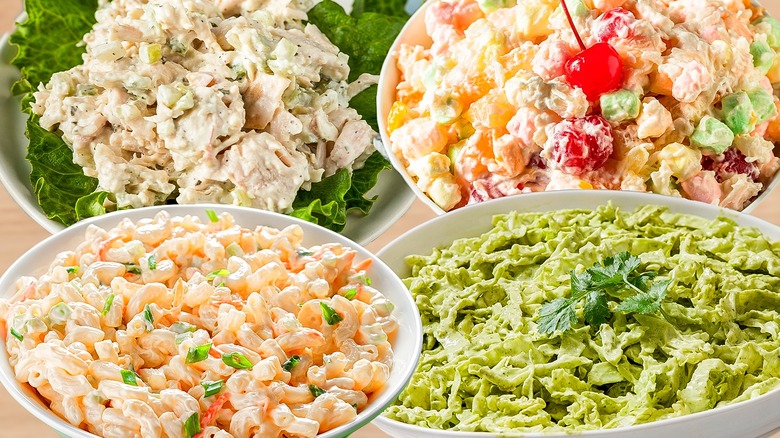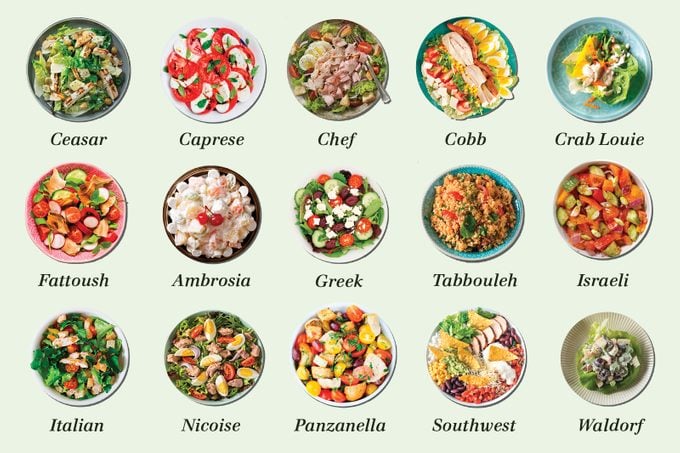The Power of Salads in a Healthy Diet
Salads are essential for a healthy diet, offering a refreshing and colorful addition to our meals. Packed with vital nutrients, they can be tailored to meet any dietary preference, making them a favorite among health enthusiasts and food lovers alike.
Importance of Salads in a Healthy Diet
Salads go beyond just leafy greens; they feature a diverse mixture of ingredients that enhance their nutritional value. Adding salads to your diet can support:
- Maintaining a balanced intake of vitamins and minerals
- Promoting digestive health with fiber-rich ingredients
- Managing weight with low-calorie, nutrient-dense options
- Improving immunity through fresh, raw vegetables and fruits
- Supporting skin health with antioxidants

Variety and Versatility of Salads
The variety and versatility of salads make them especially appealing. Move past the days of boring lettuce-only salads—there’s an exciting array of options to satisfy any taste or occasion. Consider these types:
- Fruit salads that combine the sweetness of fruits with the crunch of nuts
- Grain salads featuring quinoa, bulgur, or farro along with assorted vegetables
- Protein-rich salads with options like grilled chicken, tofu, eggs, or legumes
- Hearty salads that include roasted vegetables, cheese, and flavorful vinaigrettes
The possibilities are endless. Whether you’re in the mood for a light, crisp salad on a hot summer day or a warm, robust salad in winter, there’s always a recipe to satisfy your cravings.
Including salads in your daily routine is a simple yet effective way to improve your overall health. Their variety ensures you won’t tire of the same flavors and can consistently look forward to enjoying fresh, nutritious meals. So, explore the world of salads, experiment with different ingredients, and enjoy the numerous health benefits they offer.
Choosing Fresh Ingredients

The Importance of Using Fresh Vegetables and Fruits
When it comes to making a delicious and nutritious salad, the quality of your ingredients is key. Using fresh vegetables and fruits not only brings out the flavors and textures of your salad but also increases its nutritional value. Fresh produce typically contains higher levels of vitamins, minerals, and antioxidants, which are essential for a healthy diet. Plus, fresh ingredients provide a vibrant taste that can make your salad delightful.
Tips for Selecting the Best Produce
Picking the best produce can sometimes be overwhelming due to the wide range of options available at grocery stores and markets. Here are some practical tips to help you choose the freshest and most flavorful vegetables and fruits for your salad:
- Check for freshness indicators: Look for brightly colored produce without any discoloration or bruises. Fresh vegetables and fruits should feel firm to the touch, not wilted or soft.
- Smell the produce: When buying fruits like peaches, melons, or berries, give them a gentle sniff. They should emit a pleasant, sweet fragrance, indicating ripeness.
- Seasonal choices: Opt for seasonal produce as they are often fresher, more nutritious, and more affordable. Seasonal fruits and vegetables are usually picked at their peak, ensuring better taste and texture.
- Local markets: Whenever possible, purchase from local farmers’ markets. The produce there is often locally grown and harvested shortly before being sold, assuring freshness.
- Leafy greens: For greens like lettuce, spinach, or kale, look for crisp, vibrant leaves without any signs of yellowing or wilting.
- Bulk purchase caution: Avoid buying in bulk if you can’t consume the produce within a few days. Fresh vegetables and fruits have a limited shelf life, and they can lose their nutritional value quickly.
- Organic options: Consider choosing organic produce to avoid pesticides and artificial fertilizers, which can be harmful in the long run. Organic fruits and vegetables might be slightly more expensive but can be worth the extra cost for their health benefits.
By following these tips, you can ensure that your salad is not only tasty but also packed with the goodness that fresh ingredients provide. Happy salad making!
Diverse Types of Salads

Salads are a versatile and delightful addition to any meal, offering endless opportunities for customization and flavor combinations. They cater to various dietary preferences and provide a healthy option for individuals seeking balance in their diet. Here’s a closer look at some diverse types of salads and suggestions for tailoring them based on dietary preferences:
Overview of Different Types of Salads
Salads can be classified into several categories, each offering its unique set of ingredients and flavors. Here are some of the most popular types:
- Garden Salads: Typically made with a base of leafy greens such as lettuce, spinach, or arugula, garden salads are often topped with vegetables like tomatoes, cucumbers, and carrots. They can be dressed with a simple vinaigrette or creamy dressing for added flavor.
- Grain Salads: Featuring wholesome grains like quinoa, farro, or bulgur, these salads are hearty and filling. Grains are usually combined with vegetables, beans, nuts, and a zestful dressing. Grain salads can be served warm or cold, making them a versatile option.
- Protein-Based Salads: These salads incorporate high-protein ingredients such as grilled chicken, tofu, legumes, or hard-boiled eggs. Protein-based salads are ideal for those looking to include more protein in their diet while enjoying a variety of textures and tastes.
- Fruit Salads: Made with fresh, seasonal fruits like berries, melons, and citrus, fruit salads can be a refreshing and sweet addition to any meal. They can be enhanced with a drizzle of honey or a sprinkle of nuts for added texture.
- Pasta Salads: Combining cooked pasta with vegetables, cheese, and a savory dressing, pasta salads are great for picnics and potlucks. They can be customized with different types of pasta shapes and proteins to suit individual tastes.
Suggestions for Customizing Based on Dietary Preferences
One of the best things about salads is their adaptability to various dietary needs. Here are some suggestions for customizing salads based on common dietary preferences:
- Vegetarian: Include a variety of vegetables, grains, nuts, and seeds. Incorporate plant-based proteins like chickpeas, lentils, or tofu to ensure a good balance of nutrients.
- Vegan: Similar to vegetarian salads, but ensure all ingredients are free from animal products. Use vegan dressings and plant-based proteins. Adding avocado or nuts can provide healthy fats.
- Gluten-Free: Choose gluten-free grains like quinoa or rice. Be mindful of dressings and toppings that may contain gluten. Ensure all ingredients are certified gluten-free if needed.
- Low-Carb: Focus on leafy greens and non-starchy vegetables. Limit grains and starchy vegetables. Add high-protein ingredients like grilled chicken, eggs, or cheese.
- Keto: Incorporate low-carb vegetables and high-fat ingredients like avocado, cheese, and oil-based dressings. Avoid grains and high-carb vegetables.
The beauty of salads lies in their flexibility and the opportunity to get creative with ingredients. Whether you prefer a light garden salad or a hearty grain-based one, there’s something for everyone to enjoy!
Creating Balanced Flavors and Textures
One of the essential elements of a delightful salad lies in the balance of flavors and textures. Crafting a harmonious blend not only delights the taste buds but also ensures every bite is a pleasant experience. Here, we delve into the art and science of combining sweet, salty, sour, and bitter flavors while incorporating varied textures like crunchy, chewy, and creamy to achieve perfect salads.
Combining Sweet, Salty, Sour, and Bitter Flavors
Balancing different flavors in a salad can create a symphony for the palate. Here’s how you can achieve that:
- Sweet: Ingredients such as fresh fruits (berries, apples, mangoes), honey, and roasted vegetables (like sweet potatoes) can add delightful sweetness to your salad.
- Salty: Add a savory touch with ingredients like cheese (feta, parmesan), olives, and nuts. A pinch of sea salt can also enhance the flavor.
- Sour: Incorporate vinegar (such as balsamic, apple cider) or citrus fruits (lemons, oranges) to introduce the tangy sour notes.
- Bitter: Use greens like arugula, radicchio, or kale to include a bitter edge that balances out the other flavors.
Incorporating Crunchy, Chewy, and Creamy Textures
Salads are not just about flavors but also about how these flavors are delivered through varied textures. Here’s a breakdown:
- Crunchy: Including ingredients like croutons, raw vegetables (carrots, bell peppers, cucumbers), and seeds (pumpkin, sunflower) can add the desired crunchiness.
- Chewy: Ingredients such as dried fruits (raisins, cranberries) or cooked grains (quinoa, farro) create a chewy texture that adds an interesting contrast to your salad.
- Creamy: Ingredients like avocados, soft cheeses (goat, blue cheese), and dressings (yogurt, creamy vinaigrette) provide creaminess that offers a smooth mouthfeel, balancing crunch and chewiness.
By mindfully pairing and balancing these flavors and textures, you can create salads that are not only nutritious but also pleasingly delicious. Happy salad-making!
Homemade Dressings and Toppings
Making your own dressings and toppings at home isn’t just about customization; it’s about bringing freshness and health into your kitchen. When you prepare dressings and toppings from scratch, you have complete control over the ingredients, allowing you to avoid preservatives, excessive sugars, and unhealthy fats that can be found in many store-bought versions.
Benefits of Making Your Own Dressings
Here are some compelling reasons to consider making your dressings at home:
- Healthier ingredients: You can choose fresh and natural ingredients, ensuring you know exactly what’s in your food.
- Customized flavors: Adjust the flavors to suit your taste preferences, experimenting with various herbs, spices, and oils.
- Cost-effective: Homemade dressings often cost less than their store-bought counterparts.
- Freshness: Freshly made dressings offer better taste and nutritional value.
- Allergy-friendly: Easily avoid allergens and cater to your dietary restrictions.
By making your own dressings, you can enjoy fresh and tasty additions to your salads without worrying about any hidden unhealthy ingredients.
Popular Dressing Recipes
If you’re ready to get started, here are some simple and popular dressing recipes to try:
- Classic Vinaigrette: Combine olive oil, balsamic vinegar, Dijon mustard, honey, salt, and pepper for a simple yet versatile dressing.
- Caesar Dressing: Mix together garlic, anchovy paste, lemon juice, Dijon mustard, Worcestershire sauce, mayonnaise, Parmesan cheese, and black pepper.
- Ranch Dressing: Combine buttermilk, mayonnaise, lemon juice, garlic powder, onion powder, dried dill, and fresh chives.
- Greek Dressing: Blend together olive oil, red wine vinegar, garlic, oregano, mustard, salt, and pepper.
- Honey Mustard Dressing: Mix Dijon mustard, honey, apple cider vinegar, olive oil, and a pinch of salt and pepper.
Topping Ideas
Upgrade your salad with a variety of delicious toppings that add texture and flavor. Here are some ideas to get you started:
- Toasted nuts and seeds (e.g., almonds, walnuts, pumpkin seeds)
- Fresh or dried fruit (e.g., berries, apple slices, raisins)
- Crumbled cheese (e.g., feta, goat cheese, blue cheese)
- Fresh herbs (e.g., basil, cilantro, chives)
- Protein options (e.g., grilled chicken, chickpeas, tofu)
- Crunchy vegetables (e.g., bell peppers, cucumbers, radishes)
By preparing your own dressings and toppings, you open up a world of possibilities to make each salad unique and delightful. Experiment with different combinations and find what you love the most!
Salad Presentation and Serving Tips
Creating a beautiful and appetizing salad isn’t just about the ingredients you use; it’s also about how you present and serve your creation. Impress your guests or simply enjoy a visually appealing meal yourself with these practical tips.
Tips for Visually Appealing Presentation
When it comes to salads, we often eat with our eyes first. Here are some tips to ensure your salad is a visual treat:
- Color balance: Incorporate a variety of colors by using different vegetables, fruits, and garnishes. Think reds, greens, yellows, and purples.
- Texture play: Mix and match textures. Combine crunchy elements like nuts and croutons with softer ingredients like avocados and cheese.
- Layering: Instead of mixing all ingredients together, try layering them. This not only highlights each component but also looks more organized.
- Use edible flowers: Adding edible flowers can give your salad an exquisite look. Flowers like pansies, nasturtiums, and borage are great choices.
- Creative plating: Use different types of bowls, plates, or even mason jars for a unique presentation.
- Dress last: Dress your salad just before serving to keep the ingredients fresh and vibrant. You can also drizzle the dressing in a decorative fashion for extra appeal.
Serving Suggestions for Various Occasions
The occasion often dictates how you should serve your salad. Here are a few ideas for different events:
- Family dinners: Serve your salad in a large, colorful bowl at the center of the table. Use tongs or serving spoons for easy self-service.
- Buffets or potlucks: Use portable containers with lids. Mason jars or clear plastic cups are convenient and make serving simpler while showcasing the layers within.
- Formal dinners: Present individual portions on elegant plates. You can also use pearl or glass salad bowls to add a touch of sophistication.
- Picnics: Pack salads in lightweight, lidded containers. Individual servings in resealable bags work great for portability and easy cleanup.
- Casual gatherings: Sometimes a salad bar is the way to go. Lay out all the ingredients and let everyone build their own salads according to their preferences.
- Lunchboxes: Layer ingredients in a bento box to keep everything fresh and separated until it’s time to eat.
Conclusion
And there you have it—the complete guide to preparing the perfect salad. Let’s recap the essential steps:
- Start with a fresh and vibrant base of greens.
- Add a variety of colorful vegetables and fruits for nutrition and flavor.
- Include a protein source of your choice for added sustenance.
- Mix in crunchy elements like nuts or seeds to enhance the texture.
- Top with a homemade or store-bought dressing to bring it all together.
- Garnish with herbs or other toppings for the finishing touch.
Remember, the beauty of making salads lies in their versatility. Don’t hesitate to experiment with different ingredients and combinations. Whether you’re mixing traditional favorites or venturing into new culinary territories, the possibilities are endless. Happy salad making!

